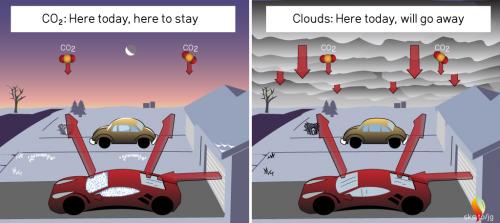
This is a reposting of an SkS analogy first posted May 2017. The first 13 comments are from the original posting.
The greenhouse effect is demonstrated by frost forming on a car window on a clear night.

Interaction of CO2, clouds, buildings, and IR radiation. At about 2°C air temperature, on a clear night frost forms on car windows. On cloudy nights no frost forms. (graphics by jg).
The greenhouse effect describes the trapping of energy by Earth’s atmosphere: infrared radiation from the ground is absorbed by gases in the atmosphere such as CO2, H2O, CH4, and others. Although the greenhouse effect is active 24/7, it is most apparent at night. This is because with no background solar radiation, nighttime warmth occurs mostly by greenhouse gases and clouds grabbing and storing some of the infrared radiation emitted from the ground that is trying to make it to outer space. This is partly why nighttime temperatures have been steadily increasing as greenhouse gases increase: more greenhouse gases implies more heating.
Everything radiates infrared radiation, but the amount emitted depends on its temperature. Because outer space is at a background temperature of about -270ºC (i.e., 3ºC above absolute 0), it emits essentially no radiation. The upper atmosphere is also much colder than the ground, so infrared energy absorbed high in the atmosphere is only weakly re-radiated back to the ground. On a clear night, therefore, the ground emits radiation to space and the upper atmosphere, but receives very little in return. The greenhouse gases in the atmosphere absorb more infrared radiation than they re-radiate back to the ground.
To see for yourself how this works, if you have a car parked outside with one side facing a house, and the other side facing an open field, and if the air temperature is about 2ºC (such as on a cool, Spring night), you will observe the following on a calm night with no clouds. If there is nothing covering the windshield of your car, it will become frosted, because as it radiates energy upward to outer space, it cools. Because it radiates more energy upward than it receives back from either outer space or the upper atmosphere, the windshield actually gets colder than the surrounding air. The same happens for the windows facing the big open field, because if the trees and buildings on the other side of the open field are short enough, then the side windows also effectively “look” at outer space on the other side of the field. However, the windows facing the house will not frost over, because although they transmit radiation to the house, the house is warm and radiates a lot of energy back to the window, keeping it warm.
On a cloudy night all of this changes, because the clouds radiate a lot of energy back to the ground, so that any windows that are looking up or to the side at the sky essentially just exchange energy with the relatively warm clouds. This prevents the windows from cooling to below the ambient temperature, keeping them unfrosted.
This object lesson with the windows of a car illustrates the kind of radiation transfer that is occurring between the ground, outer space, and the upper atmosphere, and allows you to see a clear example of how the greenhouse effect works: on a night when the air temperature is about 2ºC, with no clouds the windshield on your car becomes frosted, on a cloudy night it stays unfrosted.
Whereas clouds are like a transient, visible blanket, CO2 and other greenhouse gases are like a permanent, invisible cloak. Increasing greenhouse-gas concentrations increases the warmth of this invisible cloak, trapping more infrared radiation trying to make it out to space, keeping us warmer than we may prefer.
NOTE: if you have a very clean windshield, supercooled water may form on your windshield instead of frost. That is, clean water can cool to below 0ºC without freezing. But if you turn on your windshield wipers, the supercooled water will instantly freeze, demonstrating that the windshield is below 0ºC, even though there may be liquid water instead of frost.
Posted by Evan on Tuesday, 29 March, 2022
 |
The Skeptical Science website by Skeptical Science is licensed under a Creative Commons Attribution 3.0 Unported License. |